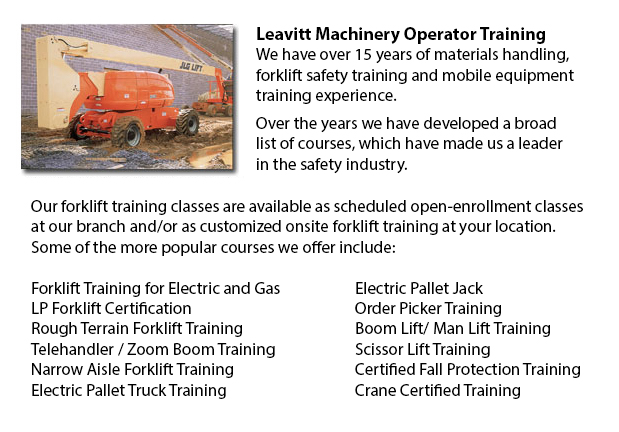
Ontario Boom Lift Certification - Elevated work platforms allow maintenance operations and work to be carried out at heights that could not be reached by any other means. Workers using boom lifts and scissor lifts could learn how to safely operate these devices by getting boom lift certification training.
When work platforms are operated unsafely, they have the potential for serious injury and even death, regardless of their lift style, site conditions or application. Falls, electrocution, tip-overs and crushed body parts could be the tragic result of incorrect operating procedures.
In order to avoid aerial lift accidents, people must be qualified in order to train workers in operating the specific type of aerial lift they would be making use of. Controls must be easily accessible in or beside the platform of boom lifts used for carrying workers. Aerial lifts must never be altered without the express permission of the manufacturer or other recognized entity. If you are renting a lift, make certain that it is correctly maintained. Prior to using, controls and safety devices must be inspected in order to make certain they are working correctly.
Operational safety procedures are important in preventing accidents. Operators must not drive an aerial lift with the lift extended (although some are designed to be driven with the lift extended). Set outriggers, if available. Always set brakes. Avoid slopes, but when needed use wheel chocks on slopes that do not exceed the manufacturer's slope restrictions. Follow manufacturer's weight and load limits. When standing on the platform of boom lifts, use a safety belt with a two-foot lanyard tied to the boom or basket or a full-body harness. Fall protection is not required for scissor lifts which have guardrails. Do not climb or sit on guardrails.
The boom lift certification course provides instruction in the following fields: safety guidelines to be able to prevent a tip-over; training and certification; slopes and surface conditions; inspecting the work area & travel path; stability factors; other tips for maintaining stability; weight capacity; leverage; testing control functions; pre-operational check; mounting a motor vehicle; safe operating practices; overhead obstacles and power lines; safe driving procedures; PPE and fall protection; making use of harnesses and lanyards; and prevent falling from the platform.
The trainee who is successful would know the following: pre-operational inspection procedures; authorization and training procedures; factors affecting the stability of boom and scissor lifts; how to prevent tip-overs; how to use PPE, how to use the testing control functions and strategies in order to prevent falls.
-
Ontario Manlift Certification
Ontario Manlift Certification - The Elevated Platforms and Manlifts Certification course helps to provide the required training on the work practices, safe operating procedures, regulations and rules regarding the everyday activities for the operator... More -
Ontario Crane Training
Ontario Crane Training - Bridge cranes or overhead cranes are actually a type of industrial material handling crane making use of a line and hook mechanism that runs on a horizontal beam running along two widely separated rails. Various overhead cran... More -
Ontario Aerial Lift Train the Trainer
Ontario Aerial Lift Train the Trainer - The Aerial Lifts Train the Trainer Certification Program teaches trainers how to effectively train operators in safe industrial mobile machinery operation. Trainers are given in-depth instruction about aerial l... More -
Ontario Warehouse Forklift Training Classes
Ontario Warehouse Forklift Training Classes - The reason for warehouse training classes are to raise the awareness of common workplace dangers. The trainees will learn essential warehouse safety procedures. An emphasis is placed on paying attention t... More -
Ontario Forklift Training School
Ontario Forklift Training School - Forklift Training School - Industry and federal regulators have established the criteria for forklift safety training based on their current standards and regulations. Those wanting to operate a forklift must finish... More -
Skid Steer Loader Training in Ontario
The engine powered skid-steer loader consists of a rigid and small frame, equipped along with lift arms that could attach to lots of industrial tools and attachments to execute many labor saving jobs. Normally, skid-steer loaders are four-wheel drive... More -
Ontario Crane License
Ontario Crane License - Crane operators ought to be "credentialed", that means they ought to own a crane operator certification or license. Credentialing is considered a mandatory governmental requirement to be able to practice as an operator of a cr... More -
Ontario Forklift Operator Training
Ontario Forklift Operator Training - Forklift training is a prerequisite in North America and is intended to prevent workplace injuries and death. Forklift training offers driver training intended for forklift operators. Training programs teach the s... More

Forklift Certification Ontario
TOLL FREE: 1-888-254-6157
Toronto, Ontario
forkliftcertificationontario.com
Email Us
About Us


